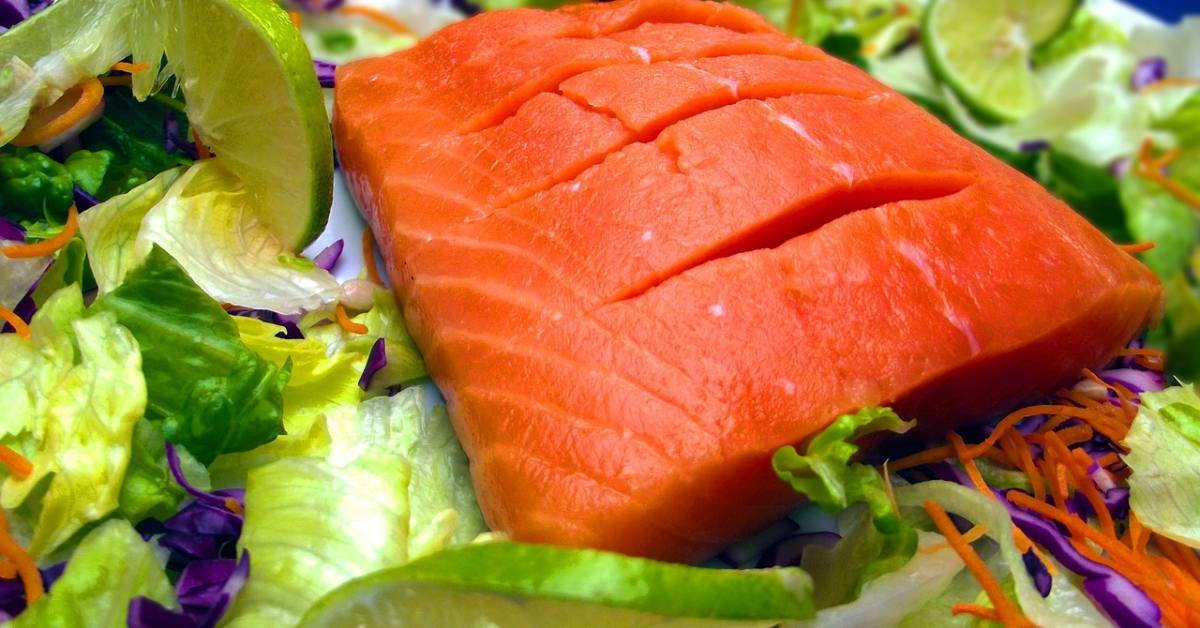There are many health benefits to eating salmon, but what are the nutrition facts? Salmon is a fish that is high in Omega-3 fatty acids, which are important for maintaining heart health and preventing chronic diseases.
Additionally, salmon is a good source of dietary protein and vitamin B12. It also contains several other nutrients that are beneficial for human health, such as selenium and potassium. By incorporating salmon into your diet regularly, you can improve your overall health and wellbeing.
Let’s look at some of the specifics of salmon nutrition facts…
Salmon Macros
A standard-sized portion of wild Atlantic salmon, which is typically around 3.5 to 4 ounces, contains a range of macro-nutrients that can provide a number of health benefits. Here’s a breakdown of the salmon macros found in this standard serving size of wild Atlantic salmon:
- Protein in Salmon: A 3.5 to 4 ounce serving of wild Atlantic salmon contains around 20-25 grams of protein, depending on the specific cut and preparation. Protein is essential for building and repairing tissues in the body, and it can also help with weight management and satiety.
- Fat in Salmon: Wild Atlantic salmon is a rich source of healthy fats, including omega-3 fatty acids. A 3.5 to 4 ounce serving of wild Atlantic salmon contains around 10-15 grams of fat, depending on the cut and preparation. Omega-3 fatty acids can help reduce inflammation, improve brain function, and support heart health.
- Carbohydrates in Salmon: Wild Atlantic salmon is a low-carbohydrate food, with less than 1 gram of carbohydrates per serving.
- How Much Calories Does Salmon Have? A 3.5 to 4 ounce serving of wild Atlantic salmon contains around 150-200 calories, depending on the preparation. This makes it a relatively low-calorie food that can be a healthy part of a balanced diet.
Overall, a standard-sized portion of wild Atlantic salmon is a nutritious and healthful food that can provide a range of macro-nutrients, including protein, healthy fats, and low levels of carbohydrates and calories.
What are some key micro-nutrients in salmon?
As previously mentioned, salmon is an oily fish that is a great source of omega-3 fatty acids, vitamin D, vitamin B12, selenium, and potassium. But what is the role of each of these nutrients?
- Omega-3 fatty acids are beneficial for maintaining heart health, preventing chronic diseases, and improving cognitive function.
- Vitamin D is important for bone health and for preventing autoimmune diseases.
- Vitamin B12 is essential for red blood cell formation and energy production.
- Selenium is a mineral that functions as an antioxidant and helps protect cells from damage.
- Potassium is important for regulating blood pressure and fluid balance.
How much salmon should you eat per week?
The American Heart Association (AHA) recommends that people eat two servings of fish per week, including at least one serving of oily fish like salmon. This will provide you with the recommended amount of omega-3 fatty acids.
Since Omega-3 content in fish varies widely, it is notable that ocean farmed Atlantic salmon, at 1.9 grams per serving, and most species of wild salmon, provide more Omega-3 fatty acids than most other fish sources. For example, fresh yellowfin tuna provides 0.2 grams per serving, swordfish provides 0.6 grams per serving and flounder. Mackerel, at 2.5 grams per serving, is another high-level source of Omega-3 fatty acids.

Different ways to prepare salmon
There are many different ways to prepare salmon, and all of them are delicious. Some of the most popular methods include baking, poaching, grilling, and frying.
Baking salmon is a great way to cook it if you want something that’s healthy and doesn’t require a lot of preparation. Simply season the fish with some salt, pepper, and herbs of your choice, then bake it in the oven for about 20 minutes. Here are more details for baking salmon properly.
And here are some other ways to prepare salmon:
- Poach salmon in a broth of ginger, garlic, and green onion
- Grill salmon with teriyaki sauce
- Sauté salmon with olive oil, lemon juice, and capers
- Salmon is also a popular choice a sushi restaurants
Salmon Nutrition Facts
Salmon is a fish that is high in protein and omega-3 fatty acids. It is also a good source of vitamin D and selenium. The health benefits of salmon include its ability to improve heart health, reduce inflammation, and promote brain health. Salmon is also a good source of nutrients for pregnant women and young children.
The USDA Nutrient Database for Standard Reference states that both wild and ocean-farmed salmon contain high Omega-3 fatty acid levels, while chicken, beef and pork contain almost no Omega-3s.
- Omega-3 fatty acids are polyunsaturated fats that are essential for life and help protect against heart disease*, as well as promote healthy skin and joints.
- Ocean-farmed salmon is a high-protein meal that is rich in Omega-3 fatty acids.
*Supportive research shows that consumption of EPA and DHA omega-3 fatty acids may reduce the risk of coronary heart disease. One serving of ocean-farmed Atlantic salmon provides 1.9 grams of EPA and DHA omega-3 fatty acids.

